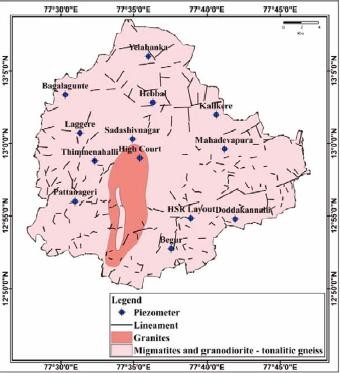 This article published in the journal Current Science highlights the acute water scarcity that the city of Bangalore has been facing over the years and examines the availability of resources in terms of climatic conditions, the available rainfall, the gradual depletion of water resources such as streams and rivers due to uncontrollable rise in the number of concrete structures in the city , which prevent infiltration of rainwater into city aquifers and promotes ‘heavy over-land flow' and the increasing dependence of the people on groundwater resources due to a drastic increase in population and the gradual decrease of availability of other water resources such as rivers and streams.
This article published in the journal Current Science highlights the acute water scarcity that the city of Bangalore has been facing over the years and examines the availability of resources in terms of climatic conditions, the available rainfall, the gradual depletion of water resources such as streams and rivers due to uncontrollable rise in the number of concrete structures in the city , which prevent infiltration of rainwater into city aquifers and promotes ‘heavy over-land flow' and the increasing dependence of the people on groundwater resources due to a drastic increase in population and the gradual decrease of availability of other water resources such as rivers and streams.
The article informs that even though a potential of 35,605 ha m from rivers sources has been created by the BWSSB to meet the needs of the people in the city, the actual water supply after conveyance and losses of nearly 30% is only 24,923 ha m. This deficit gets met through uncontrolled digging of borewells and drawing on groundwater resources.
While the geohydrological and drilling data have revealed absence of potential fractures beyond 280 m depth, now bore wells are being drilled around 300 m, mostly in the peripheral parts, implying the extraction of static groundwater resources. For example, according to a recent study, 30% of bore wells were at 100 m depth, 54% were between 100 and 200 m, 15% between 200 and 300 m and 0.56% beyond 300 m depth, signifying a severe crisis similar to mining of groundwater resources.
The present scenario is that against an annual demand of 48,600 ha m, only 37,374 ha m is now being supplied from both surface and groundwater resources. The shortage in supply of nearly 11,226 ha m of water spells water scarcity for nearly 22 lakh people, even after excessive exploitation of 9,161 ha m/yr of groundwater against the annual recharge. The article warns that in case the city aquifers become barren because of over exploitation, an additional 24.38 lakh population in the city will be badly affected.
The article ends by proposing some steps that can be undertaken in the light of this grave water scarcity and over exploitation of groundwater resources:
- The storm water discharge of 17,040 ha m/yr (which is being wasted by being drained along with the sewage water) to be protected and conserved, which could meet the requirement of about 23 lakh people, i.e. nearly 24% of the city population
- Total sewage load of 26,316 ha m/yr being generated in the city to be treated up to tertiary level and brought to the safe standard of domestic and drinking water usage and even 70% of such treated water when made available, can serve about 26 lakh people in the city. Thus, the surface run-off and the treated sewage water together can serve the water requirement of about 50 lakh people, i.e. 53% of the city population
- Better management and judicious usage of the water resources available within the city can prevent the uneconomical and anti-environmental proposals like diversion of water from the west-flowing rivers like the Nethravati in the Western Ghats and/or from distant river systems like the Krishna
A copy of the article can be accessed at this link
/articles/resource-availability-water-supply-bangalore-city-karnataka-article-published-journal